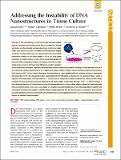| dc.contributor.author | Hahn, Jaeseung | en_US |
| dc.contributor.author | Wickham, Shelley F. J. | en_US |
| dc.contributor.author | Shih, William M. | en_US |
| dc.contributor.author | Perrault, Steven D. | en_US |
| dc.date.accessioned | 2015-09-01T13:28:09Z | |
| dc.date.issued | 2014 | en_US |
| dc.identifier.citation | Hahn, Jaeseung, Shelley F. J. Wickham, William M. Shih, and Steven D. Perrault. 2014. “Addressing the Instability of DNA Nanostructures in Tissue Culture.” ACS Nano 8 (9): 8765-8775. doi:10.1021/nn503513p. http://dx.doi.org/10.1021/nn503513p. | en |
| dc.identifier.issn | 1936-0851 | en |
| dc.identifier.uri | http://nrs.harvard.edu/urn-3:HUL.InstRepos:21462158 | |
| dc.description.abstract | DNA nanotechnology is an advanced technique that could contribute diagnostic, therapeutic, and biomedical research devices to nanomedicine. Although such devices are often developed and demonstrated using in vitro tissue culture models, these conditions may not be compatible with DNA nanostructure integrity and function. The purpose of this study was to characterize the sensitivity of 3D DNA nanostructures produced via the origami method to the in vitro tissue culture environment and identify solutions to prevent loss of nanostructure integrity. We examined whether the physiological cation concentrations of cell culture medium and the nucleases present in fetal bovine serum (FBS) used as a medium supplement result in denaturation and digestion, respectively. DNA nanostructure denaturation due to cation depletion was design- and time-dependent, with one of four tested designs remaining intact after 24 h at 37 °C. Adjustment of medium by addition of MgSO4 prevented denaturation. Digestion of nanostructures by FBS nucleases in Mg2+-adjusted medium did not appear design-dependent and became significant within 24 h and when medium was supplemented with greater than 5% FBS. We estimated that medium supplemented with 10% FBS contains greater than 256 U/L equivalent of DNase I activity in digestion of DNA nanostructures. Heat inactivation at 75 °C and inclusion of actin protein in medium inactivated and inhibited nuclease activity, respectively. We examined the impact of medium adjustments on cell growth, viability, and phenotype. Adjustment of Mg2+ to 6 mM did not appear to have a detrimental impact on cells. Heat inactivation was found to be incompatible with in vitro tissue culture, whereas inclusion of actin had no observable effect on growth and viability. In two in vitro assays, immune cell activation and nanoparticle endocytosis, we show that using conditions compatible with cell phenotype and nanostructure integrity is critical for obtaining reliable experimental data. Our study thus describes considerations that are vital for researchers undertaking in vitro tissue culture studies with DNA nanostructures and some potential solutions for ensuring that nanostructure integrity and functions are maintained during experiments. | en |
| dc.language.iso | en_US | en |
| dc.publisher | American Chemical Society | en |
| dc.relation.isversionof | doi:10.1021/nn503513p | en |
| dc.relation.hasversion | http://www.ncbi.nlm.nih.gov/pmc/articles/PMC4174095/pdf/ | en |
| dash.license | LAA | en_US |
| dc.subject | Article | en |
| dc.subject | DNA nanotechnology | en |
| dc.subject | DNA origami | en |
| dc.subject | cells | en |
| dc.subject | | en |
| dc.subject | tissue culture | en |
| dc.subject | nuclease | en |
| dc.subject | stability | en |
| dc.subject | structural integrity | en |
| dc.subject | cation | en |
| dc.subject | nanorobot | en |
| dc.title | Addressing the Instability of DNA Nanostructures in Tissue Culture | en |
| dc.type | Journal Article | en_US |
| dc.description.version | Version of Record | en |
| dc.relation.journal | ACS Nano | en |
| dash.depositing.author | Hahn, Jaeseung | en_US |
| dc.date.available | 2015-09-01T13:28:09Z | |
| dc.identifier.doi | 10.1021/nn503513p | * |
| dash.contributor.affiliated | Wickham, Shelley F. J. | |
| dash.contributor.affiliated | Perrault, Steven D. | |
| dash.contributor.affiliated | Hahn, Jaeseung | |
| dash.contributor.affiliated | Shih, William | |


